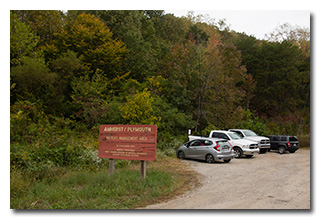
by William Eric McFadden
From the West Virginia Explorer entry:
-
The 7,061-acre Amherst-Plymouth Wildlife Management Area (WMA) is forested in young oak and hickory. Its terrain consists chiefly of low ridges and small valleys that descend toward bottomland along the Kanawha River.
Pictures
Description
 On Saturday, October 10, 2020, one member of the Southeast Ohio Radio Adventure Team
performed a successful activation of Amherst/Plymouth Wildlife Management Area in West Virginia as part of the Parks on the Air (POTA; link) program.
This was the first CW POTA activation of Amherst/Plymouth Wildlife Management Area.
On Saturday, October 10, 2020, one member of the Southeast Ohio Radio Adventure Team
performed a successful activation of Amherst/Plymouth Wildlife Management Area in West Virginia as part of the Parks on the Air (POTA; link) program.
This was the first CW POTA activation of Amherst/Plymouth Wildlife Management Area.
Eric McFadden, WD8RIF, performed the activation of Amherst/Plymouth Wildlife Management Area on the gated Plymouth Hollow Road, with road construction underway on the adjacent highway, and rain from the remnants of Hurricane Delta falling. Eric was accompanied by his wife Vickie and their small dogs, Theo and Mindy.
Eric, Vickie, and the dogs arrived at the Plymouth Hollow Road area at about 1400 UTC, about thirty minutes later than Eric had planned to arrive. Eric had hoped to proceed up Plymouth Hollow Road to one of the several open areas visible on the Google satellite view but found the road to be gated and locked a few hundred feet beyond the WMA sign. Eric then thought to set up his station in the pull-off across Plymouth Road from the WMA sign, but upon finding a dead fox and a dead raccoon on a pile of brush there, he decided to set up in the parking area adjacent to the WMA sign, the parking area that was occupied by pickup trucks and an SUV of the roadway construction workers. Fortunately, there was still ample space for the Honda Fit and, while Vickie walked the dogs, Eric deployed his 28½' wire antenna on his 31' Jackite telescoping fiberglass mast and drive-on base. Because of the continuing rain, Eric set up his KX3 inside the car and was on the air by 1416 UTC.
Eric was pleased to find he had good cell-signal at the site and was able to spot himself to the POTA Spots website.
Eric began operations on 80m and his first QSO came at 1419 UTC with his good friend K8RAT in Ohio. When subsequent QSOs on 80m were slow in coming, Eric took the opportunity to check POTA Spots for possible park-to-park (P2P) QSOs and at 1424 UTC succeeded in making a P2P QSO on 20m with AA5W who was activating Huntsville State Park (K-3019) in Texas, and at 1426 UTC succeeded in making a P2P QSO on 20m with K5G, a Get Your Park On! special event station that was activating Palmetto State Park (K-3045) in Texas. Returning to 80m to run his own frequency, Eric had a QSO at 1428 UTC with his good friend K4SWL in North Carolina and at 1433 UTC had a QSO with KU4R in Tennessee.
Taking the opportunity to hunt for more P2P QSOs, at 1433 UTC Eric made a P2P QSO on 40m with N2G, a Get Your Park On! special event station that was activating Morristown National Historical Park (K-0746) in New Jersey, and at 1435 UTC he made a P2P QSO on 80m with AC8RG who was activating Sycamore State Park (K-1995) in Ohio.
Switching to 40m to run his own frequency, Eric had a run of eleven QSOs in twelve minutes, starting with a QSO at 1440 UTC with big-time POTA Hunter VE3LDT in Ontario and ending with a QSO at 1452 UTC with KO4YB in Alabama. This run of QSOs included a P2P QSO with K0BWR who was activating McPherson State Fishing Lake (K-7417) in Kansas.
Eric switched to 20m at 1455 UTC but several minutes of calling CQ resulted in no replies. Taking a final opportunity to hunt parks, at 1503 UTC Eric managed a P2P QSO on 40m with WK4WC who was activating Dreher Island State Park (K-2893) in South Carolina.
In all, Eric made nineteen QSOs, of which six were P2P QSOs. All of Eric's QSOs were CW and were made at the 5-watt level.
(return)